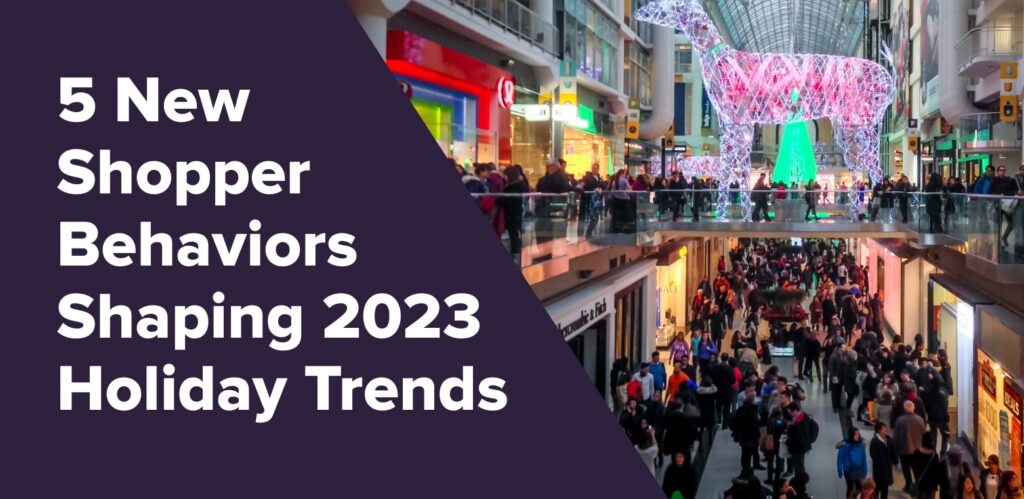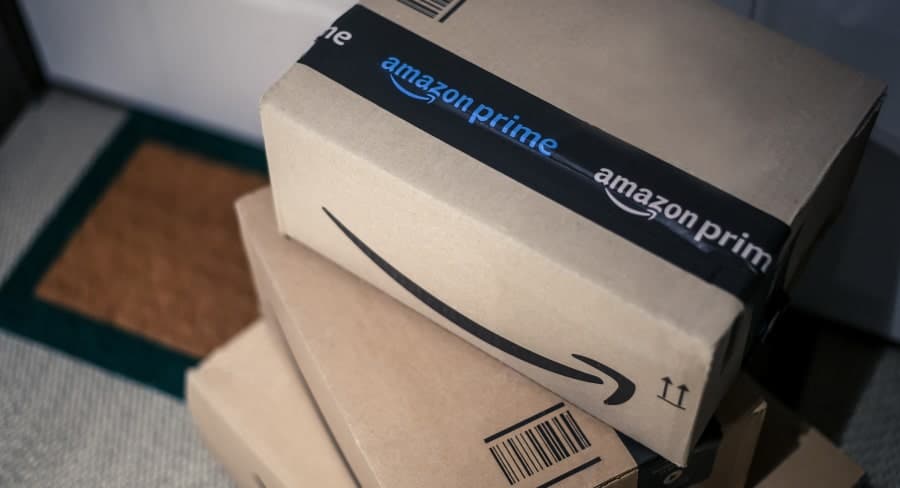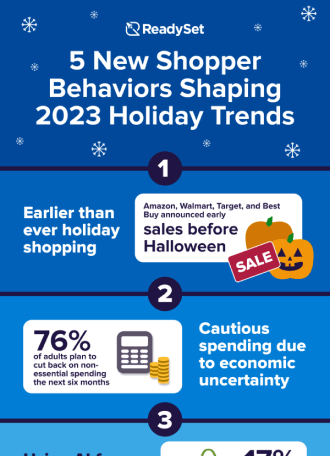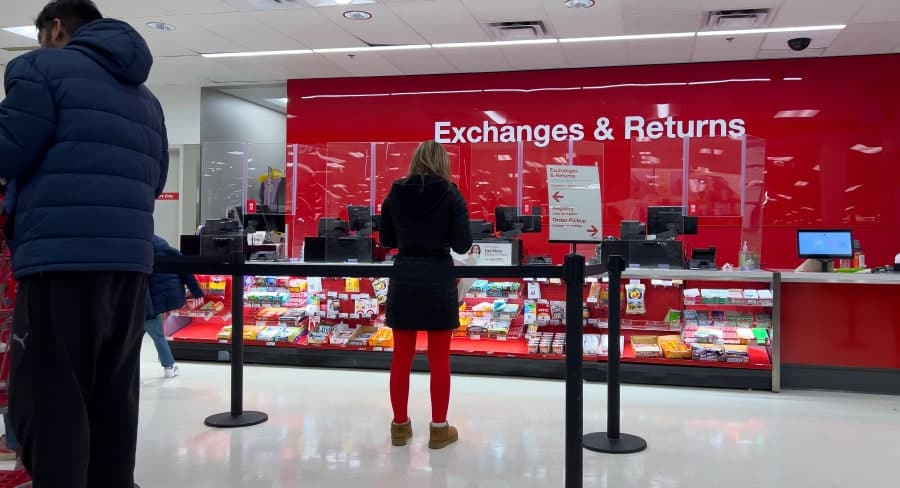5 New Shopper Behaviors Shaping 2023 Holiday Trends

The 2023 holiday shopping season includes several new and intriguing behaviors that are altering the retail landscape.
The approaching holiday months are often considered the biggest and most important time of the year for retail in terms of sales and revenue. Shoppers increase their spending on gifts, decorations, food, and other holiday-related items. This creates the perfect opportunity for special promotions and programs that attract shoppers and drive sales.
Holiday retail sales from events like Black Friday and Cyber Monday have been especially popular and highly anticipated. However, as we step into 2023, it's clear that holiday shopping consumer behavior is undergoing a transformation like never before. To maintain their margins, brands are adjusting their holiday retail sales strategies to meet these new shopper needs.
Let's take a look at the top 2023 holiday shopping predictions, along with the expert advice being given to brands and retailers.

1. Earlier than ever holiday shopping
The trend of early holiday shopping, which gained momentum in 2022, shows no signs of slowing down in 2023. Last year, Black Friday deals started surfacing more than a month before the traditional holiday shopping season. With a survey by the NRF revealing that a remarkable 56% of consumers seized the opportunity to snag early holiday deals before Thanksgiving. This shift in consumer behavior has now become a holiday retail staple, with major players like Amazon, Walmart, Target, and Best Buy all announcing early sales that kick off even before Halloween.
Expert advice for retailers:
- Grab Attention Early: To succeed in this evolving landscape, retailers should aim to capture consumers' attention early in the season.
- Adopt an "Always On" Approach: Embrace an "always on" marketing strategy to stay relevant and engage with shoppers consistently.
- Sooner Strategic Testing: Consider conducting testing and market research well in advance, possibly up to a year ahead, to anticipate and respond to shifting consumer preferences effectively.

2. Cautious spending due to economic uncertainty
Looking back at holiday spending in 2022, consumers embraced caution amid rising inflation. Although 2023 has seen some relief from previous peaks in inflation, the persistent high costs are prompting consumers to remain vigilant. Shoppers are expected to seek value through buying items on sale, buying less, and using more coupons.
Holiday spending statistics in a survey by CNBC and Morning Consult revealed that 92% of adults have reduced their spending over the past six months and 76% plan to cut back on spending for non-essential items over the next six months. This holiday shopping behavior suggests that consumers are on the lookout for discounts and cost-effective options as they approach the upcoming holiday season.
Expert advice for retailers:
- Offer Compelling Sales and Discounts: While this may entail a sacrifice in margin or profitability, it remains a crucial strategy for meeting customer needs during this economically uncertain season.
- Utilize Buy Now, Pay Later: Recognize the growing popularity of the “buy now, pay later” payment method that shoppers use to stretch their budgets when spending more than intended.
- Optimize Inventory Management: Employ sophisticated demand forecasting to fine-tune your inventory management processes to minimize overstocking and understocking.

3. Using AI for gift inspiration and shopping lists
It has dominated headlines all year, so of course 2023 holiday shopping trends will also include AI. Although the technology is still viewed skeptically by the public majority, a report by Salesforce confirms that 17% of shoppers say they’ve used generative AI as a shopping assistant to inspire purchases, do product research and make shopping lists. From this data, we can predict that a portion of consumers will use Google shopping AI and ChatGPT to find gifts while holiday shopping in 2023.
Brands and retailers have already harnessed the potential of AI for years to enhance various facets of their operations and customer interactions. Common applications include AI product recommendations and chatbots for ecommerce transactions, precise price forecasting, and optimized inventory management. As these technologies advance and gain wider acceptance among consumers, we are witnessing a plethora of innovative business applications emerging for holiday marketing and sales.
Expert advice for retailers:
- Generate Best Offers using AI: Analyze customer behaviors, predict trends. Identify your most profitable customers, and then create a plan to drive repeat purchases.
- AI Content Generation: Draft content for emails, landing pages, text messages, social media, and apps.
- Use AI for Automation and Operational Efficiency: use predictive and generative AI for operational efficiencies and personalized shopping experiences. Automate segments and map content journeys.
Download the infographic
Easily share these insights! Get a free download of ReadySet's "2023 Holiday Shopping Behavior Trends" infographic.


4. Shopping the resale market for sustainable secondhand gifts
The resale market has boomed on the internet, especially for unique vintage and nostalgic items. Shoppers are increasingly drawn to buying secondhand gifts due to their desire for sustainability and cost-saving, particularly during times of economic uncertainty. This shift in attitude has helped break the stigma associated with giving used gifts.
Salesforce has predicted that 17% of gifts this holiday season will be a resold item. This choice not only saves money but also contributes to sustainability efforts, preventing a whopping 32 billion pounds of waste from ending up in landfills. Additionally, shoppers prefer this option because it allows for quicker product delivery compared to some new items. Surprisingly, more than one in three consumers plan to gift a used item to someone else in the next six months.
Expert advice for retailers:
- Resale Integration: Develop a dedicated platform for reselling used items or encourage customers to participate by offering enticing incentives like store credits or discounts.
- Curated Collections: Utilize damaged or pre-owned items by redesigned collections of one-of-a-kind items that align with their brand and customer preferences.
- Sustainability Initiatives: If resale or secondhand products don't align with your current product offerings, consider shining a spotlight on your sustainability initiatives. Emphasizing your commitment to environmentally-friendly practices can resonate with conscious consumers and strengthen your brand's appeal.

5. Making purchase decisions from shipping and return policies
Holiday consumer trends in 2022 consisted of rising costs and increased returns that led to around 60% of retailers saying they would change existing returns policies and no longer promising free returns. These changes left holiday shoppers with shorter return windows and shipping or restocking fees that retailers hoped would deter the increasing amount of returns.
Results of last year's holiday shopping season revealed that returns were largely increased from 2021. Retailers focused their efforts on increased return restrictions rather than creating better experiences. Leading to lowered consumer confidence and making them think twice about their purchases. If this pattern continues, it is likely increasing returns will trickle into holiday 2023 trends.
As we look ahead to the holiday shopping trends in 2023, it's crucial for retailers to consider how to address the challenge of increased returns. By enhancing the returns experience and implementing strategies to reduce return rates, retailers can ensure a more positive shopping experience for consumers while also safeguarding their own bottom line.
Expert advice for retailers:
- Clear/Easy Return Policies: Maintain transparent and customer-friendly return policies. While adjustments may be necessary, ensuring that return policies are easily accessible and easy to understand can help retain customer trust.
- Enhance your product pages: Improve your product information pages with reviews, videos, images, and interactive forums to empower consumer decisions.
- Proactive Customer Support: Proactively engage with customers to address their concerns and resolve issues before they decide to return a product.
Subscribe to our newsletter
Get our blogs and the latest retail news delivered to your inbox monthly.
Recent Posts
How to Use 3D VR for Smarter Store Layout and Design
Explore how VR is revolutionizing grocery store layout and design planning by offering enhanced blueprint visualization in immersive 3D environments. Grocery store layout strategy is essential for establishing a positive and productive customer experience. A thoughtfully designed layout not only improves convenience but also fosters a sense of discovery, leading to longer, more enjoyable shopping…
Sauce & Condiment Sales Heat Up as New Tech Helps Out
Young Millennials and Gen Z consumers have fueled a boom in hot sauce trends and condiment sales. This surge is pushing leading brands and retailers to elevate their game with smarter virtual product innovation and assortment optimization. The condiment and hot sauce industry is thriving in 2024, driven by evolving consumer tastes and the growing…
Candy, Bar, and Snack Industry use VR to Keep Up with Consumers
Discover the snack trends of 2024 that are pushing the snack bar market and candy industry to innovate and evolve using cutting-edge technology. The Convenience Store News 2024 Industry Deep Dive revealed numerous snack food industry trends, highlighting a shift toward healthier snacking options and a growing preference for savory flavors. As various snack categories…



